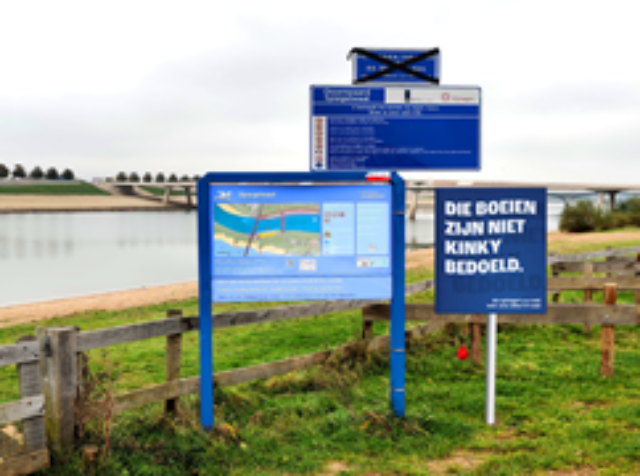Waal%20information%20board.png)
Waal%20information%20board.png)
Read more on the Connected River website
about the pilot area
Results - Information needs
Situation
The (Spiegel)Waal has been built to withstand a larger river discharge. At the same time, it has grown into an attractive hotspot for recreationists and water sports enthusiasts. In recent years, many developments have taken place. For example, the development of the water sports centre ‘’Het Bastion’’. This ensures many different users, such as rowers, sailors, swimmers, recreational users and pleasure craft, come together, each with a different goal. This increases the interaction between users and thus the risk of dangerous situations, especially on busy summer days.
New users bring new opportunities and challenges. There are problems with supervision and safety in the area. The users are not sufficiently familiar with the risks, hazards and (behavioural) rules at this location. With a solution-oriented experiment, the goal was to look at how we can work together with local organizations and users on a sustainable, safe, connected city on the water.
Solution direction
Through exploratory sessions with representatives of the rescue brigade and police, residents, administrators of the area, users and other partners involved, the experiment team came up with the idea to provide up-to-date information (on location) through (digital) information provision that stands out/triggers (e.g. social media).
- The assumptions of the solution direction
- People are aware of the conditions in the area and can therefore better assess the safety situation.
- The user feels safer/better informed.
- They indicate that they act according to (behavioural) rules.
Now that the experiment team had chosen a solution direction, they enlisted the help of the research and design agency Bureau B302 to visually work out and test the solution direction testing against the wishes and needs of users. Bureau B302 is a full-service agency, entirely student based, they combine code, creativity, image and communication. The agency functions within the department IT and Media Design at the HAN University of Applied Sciences.
Hypotheses
To test whether the solution direction suits the users’ needs, the following hypotheses have been formulated:
- The user experiences up-to-date information regarding safety (temp/pressure/water quality/supervision/events) and (behavioural) rules, valuable.
- The user is aware of the dangers, rules and desired behaviour in the area after seeing the proposed solution.
- The users act accordingly to the desired (behavioural) rules.
The hypotheses have been tested by conducting on-site interviews with the water users, by the students. The students have designed different ways of providing information to the users. With iterations, the students came up with a design to display information and tested this several times with the users. When the hypothesis can be answered with 'yes' by 50% of the respondents, then it is successful (the desired success rate). Their results have shown that there is a need for information and that users expect to change their behaviour when they become more aware of the water condition and the (behaviour) rules.
The experiment team has gained in-depth insights into users’ needs and desires for up-to-date information (on location) through (digital) information. The next step to run the experiment will be to test an information board on the waterside. The image below shows the most popular design among the users.
Lessons learned - Pitfalls and tips
- When exploring possible solution directions, you are constantly looking for new innovative ideas to test with stakeholders and users. It is easy to quickly have a preference for a certain solution. Remain transparent with (stakeholders, users, innovation partners, etc.), do not set frameworks too quickly and share background information, so that as many possible solutions are created.
- There is a risk that you want to design everything yourself, but this makes the solution a lot less feasible. Explore the context of your experiment so that you know what is available, there may be solutions similar to your solution direction with which you can test quickly and easily.
- Organizations you involve are often not familiar with working with short-cycle innovation. It is important to always record agreements in collaboration with external parties. Remember to formulate SMART agreements; make clear goals and agreements; and plan and expectations.
- Stakeholder and users are often not used to working in (co-)design of the solution. Ensure good expectation management, make agreements about project updates and comply with them. Not everyone involved goes through the whole process, so during the project phases, you need to keep them informed about the progress. Assumptions might change due to a progressive insight. The outcome of an experiment is not fixed and will continuously be improved.
